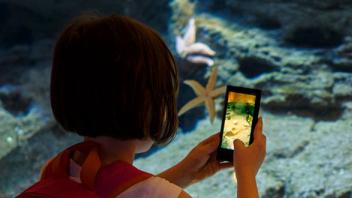Taking pictures, audio, and video
Just about every cell phone has a digital camera built into it. Many phones can also take short bits of video. Begin by helping your child learn how to use the camera correctly by holding it as still as possible and learning how to use the telephoto and wide angle button (if available). Then, encourage your child to think big and small! Encourage pictures of bigger things such as animals and trees, as well as smaller things such as bugs, butterflies, flowers, and spider webs. Older children may enjoy taking “mystery pictures,” which can be close-up or partial pictures of ordinary things in nature.
(Note: Ask your child to use a simple field guide to keep track of what each mystery picture actually is!)
The diligent nature lover may be able to capture video of an ant carrying food, a butterfly drinking nectar, or a worm digging into the earth. Use the video recorder, or audio recorder, to capture the sounds of nature too. A creek with rushing water and different bird calls are two great nature sounds to capture.
Exploring your pictures and video
When you get home, spend some time matching the images your child captured with flower and insect guides, or work together to search the Internet for images. See how many insects or flowers your child is able to match up and identify. To create a lasting memory, print out your child’s favorite pictures, label them, and turn the pages into a nature book. Simple video editing tools enable children to write short captions for the video footage they took: butterfly lands, butterfly drinks, butterfly flies away!
Sharing pictures, audio, and video
Nature photos can also be uploaded to share with a wider audience. Together, you and your child can use simple presentation software like PowerPoint or Keynote to create a nature slideshow. Or use an online photo sharing site like Picasa, Flickr, or Snapfish to share photos with friends and family. To create an ongoing nature project, consider using a kid safe blogs or social network site.
Putting your child in charge of taking, exploring, and sharing nature pictures and videos puts them in charge of all sorts of important scientific tasks. Observing the environment, selecting something to record, recording the event (through picture, audio or video), identifying the subject and sharing with an audience are all important parts of the inquiry process.
Recommended children’s books

ABCs Naturally: A Child’s Guide to the Alphabet Through Nature

Birds

Butterflies and Moths

Look Book

Snowflake Bentley
Download this article in Spanish
Subscribe to Growing Readers!
Get our free monthly parent tips — in English and Spanish — delivered right to your inbox!
